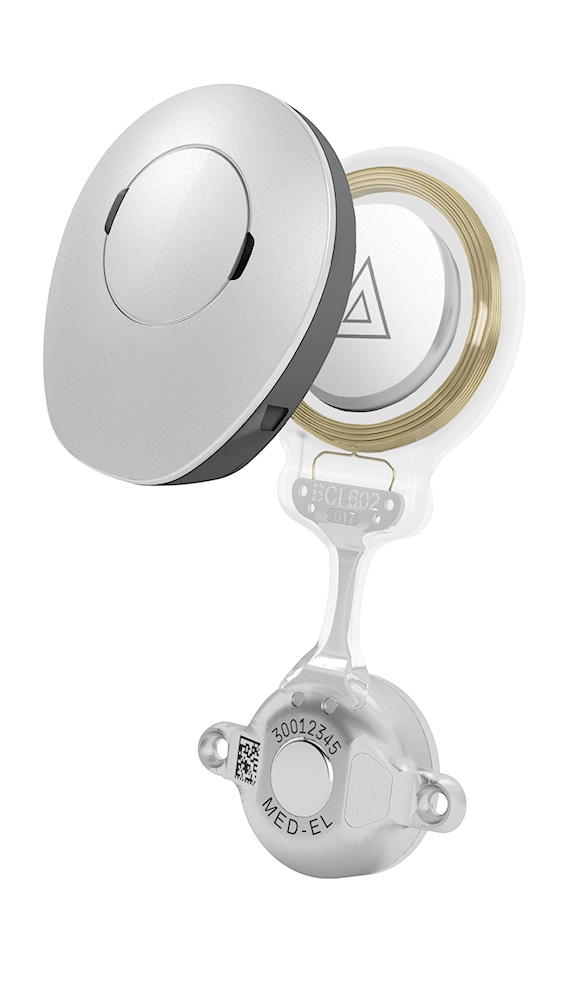A new implant for an excellent hearing experience – BONEBRIDGE!
Years ago, MED-EL introduced the first bone conduction system, in which the implant sits completely below the intact skin. A new implant, the BCI602 has also been available since the end of last year.

For people with a sound conduction and combined hearing loss, the sound waves cannot reach the inner ear in the required quantity. Affected persons can benefit the most from hearing systems that transfer the sound directly to the inner ear. For decades, they have primarily had bone conduction spectacles or bands available, while children later had forehead bands as well. Depending on the system, these devices have to make a relatively high pressure on the skin, which makes them both uncomfortable and cosmetically unfavourable. The first implantable systems operated with an implanted screw that conducts the sound to the bone through the open skin.
In 2012, MED-EL set a new standard in bone conduction systems with the BONEBRIDGE. The BONEBRIDGE is the world’s first active transcutaneous bone conduction implant. Experts and users confirm outstanding hearing outcomes with this, and scientific studies show both hearing success and particular reliability[1]. A new implant has been available for the system since the turn of the year -the BCI602. It delivers the same excellent hearing experience but is only half the thickness of its predecessor. It is possible to fix it using self-drilling screws. Less drilling is needed in the implantation, so the operation and recovery times are shorter.
Smaller, narrower, better

The new BONEBRIDGE BCI602 bone conduction implant is half the thickness of its predecessor, but offers the same excellent hearing experiences. ©MED-EL
“It is really nice to implant the new BONEBRIDGE”, enthuses Univ.-Prof. Dr. Georg Sprinzl, head of the ENT department in the University Clinic of St. Pölten, in the MED-EL blog. The BCI602 is in principle another active bone conduction implant. Chief Doctor Priv. Doz. Dr. Astrid Magele, MBA, also from the University Clinic of St. Pölten, explains, “What I like most about this implant is that it is a transcutaneous implant. The skin is closed again over the implant and that is a great advantage to the patient.” The transmitter that passes on the mechanical sound energy is integrated in the implant and not in the audio processor. The closed skin prevents bacteria from entering the implant area.
Prof. Sprinzl sees an advantage in the shorter operation time for the BCI602: “We have just needed 15 minutes to fit the implant from the first incision to the last stitch. The benefit to patients is that the wound is smaller, so that means recovery from the operation is faster.“ He adds that the sound quality is good and that this system can be activated soon after the implantation in comparison with other bone conduction implants. Dr. Thomas Rasse, Chief Doctor at the Klinikum Wels-Grieskirchen, sees the advantage in “that it is better to implant, especially in those difficult anatomical cases, for example, with children, or for patients who have already has several operations.“
Symbiosis to the Benefit of the User
The new BCI602 s developed on the basis of the good outcomes with the predecessor model, where clinical experiences fed directly into the further development. “It is fantastic to see how MED-EL considers suggestions and feedback from surgeons to improve the implant”, says Dr. Rasse. “It is a symbiotic relationship between the developer and the surgeons.”
Bone conduction hearing systems are the expedient solution if a large part of the hearing problem is in the conduction of sound: for example, in patients with otosclerosis, where there is pathological narrowing of the external auditory canal, so-called stenosis, where there is chronic obstruction of the tubes or many other pathological symptoms. Along with traditional bone conduction hearing aids and the adhesive hearing aid ADHEAR, affected persons have three types of bone conduction implants available: in the conventional BAHA, a metal screw is screwed into the cranium, the end of which protrudes through the skin and serves as a fast connector for the audio processor. The actual sound is emitted from the processor, the fast connector transmits it to the bone. In the magnetic BAHA, the fast connection is replaced by magnetic fixing of the processor. The skin can be closed, but the sound is still emitted by the processor meaning it must pass through the muffling effect of the skin. That is not the case with active bone conduction implants!
Active and direct
The active bone conduction implant is implanted in the bone and the skin is allowed to heal completely over it. The audio processor, held in place magnetically, conceals the microphone but the sound is emitted directly into the bone by the implant, near the inner ear. This enables the highest sound quality and the local separation between microphone and sound emission also leads to increased safety against feedback whistling. Even if systems have recently been trying to imitate the principle with different technologies, the BONEBRIDGE guarantees unmatched sound and leading performance as the only active bone conduction implant based on electromagnetism. The experiences of nearly a decade with the BONEBRIDGE have fed into the new BCI602, and users benefit from the symbiosis of experience and innovative new developments.
More information about the new BONEBRIDGE BCI602 at https://blog.medel.com/the-bonebridge-bone-conduction-implant/
[1] White Paper






